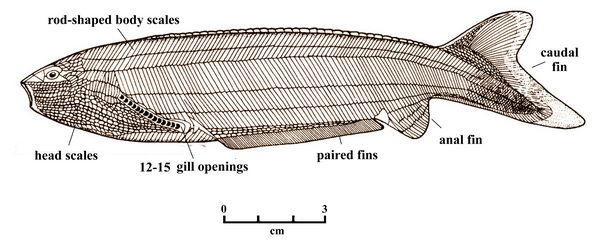Athena Review Image Archive ™
Pharyngolepis

Pharyngolepis (drawing after Norsk Geologisk Forening).
Pharyngolepis was a jawless fish from the Late Silurian period (470-455 mya), found in the Baltic region of Norway. The name means "scaly throat" (Pharyngo- "pharyx" or "throat"; -lepis "scale"). They belong to to the phylum Chordata, the subphylum Vertebrata, and the class Anaspida.
The exoskeleton of anaspids is made up of aspidine and contains no dentine. The head is covered with minute scales and platelets forming the skull-roof. There was a row of spines along the back. Anaspids, with a body lengrth of 10-15 cm, have a laterally compressed body, an anal fin, and thin, sometimes ribbon-shaped paired fins.
Pharyngolepis is the most generalized of jawless anaspids. Owing to its slim body, it was once thought to be a close relative or ancestor of lampreys. However, most characteristics thought to support this relationship are now known to occur in many other fossil taxa.
Pharyngolepis had well-developed anal and
caudal fins, but lacked other means to stabilize it while swimming. It
probably stayed close to the sea bottom. Pectoral fins were instead
replaced by bony spines, possibly for protection against
predators. The
skull-roof displays a median pineal “eye” opening. Between the two
orbits, and in front of it there is a peculiar keyhole-shaped opening
interpreted as a dorsal nasohypophysial opening.
Reference:
Janvier, Philip 1997
.Copyright © 1996-2020 Rust Family Foundation (All Rights Reserved).